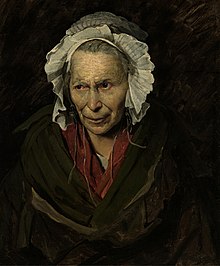Monomania
| Monomania | |
|---|---|
 | |
| Portrait of a woman titled Monomania of Envy by Théodore Géricault[1] | |
| Specialty | Psychiatry |
In 19th-century psychiatry, monomania (from Greek monos, "one", and mania, meaning "madness" or "frenzy") was a form of partial insanity conceived as single psychological obsession in an otherwise sound mind.[2]: 155 [3]: 26
Types
[edit]Monomania may refer to:
- Erotomania (also known as De Clerambault's syndrome): Delusion that a particular man or woman is in love with the patient. This can occur without reinforcement or even acquaintanceship with the love object.
- Idée fixe: Domination by an overvalued idea, for example, "staying thin" in anorexia nervosa
- Kleptomania: Irresistible urge to steal
- Pyromania: Impulse to deliberately start fires
- Lypemania: Early elaboration later to become modern concept of depression[4]
- Narcissism: Pursuit of gratification from one's own attributes
- Homicidal monomania: According to Étienne-Jean Georget, an abrupt "lesion of the will" capable of driving an otherwise sane person to murder[5]
History
[edit]Partial insanity, variations of which enjoyed a long prehistory in jurisprudence, was in contrast to the traditional notion of total insanity, exemplified in the diagnosis of mania, as a global condition affecting all aspects of understanding and which reflected the position that the mind or soul was an indivisible entity.[3]: 25–6, 31, 39 [6]: 243 Coined by the French psychiatrist Jean-Étienne Dominique Esquirol (1772–1840) around 1810,[2]: 153 monomania was a new disease-concept characterised by the presence of an expansive fixed idea, in which the mind was diseased and deranged in some facets but otherwise normal.[2]: 157 Esquirol and his circle described three broad categories of monomania, consistent with their three-part classification of the mind into intellectual, emotional and volitional faculties.[7]: 46 Emotional monomania is that in which the patient is obsessed with only one emotion or several related to it; intellectual monomania is that which is related to only one kind of delirious idea or ideas. Although monomania was retained as one of seven recognized categories of mental illness in the 1880 US census,[8] its importance as a psychiatric diagnostic category was in decline from the 1850s on.[9]
See also
[edit]- Autism
- Addictive behaviour
- Attention deficit hyperactivity disorder
- Idée fixe (psychology)
- Obsessive–compulsive disorder
- Moral insanity
References
[edit]- ^ "Monomania of Envy".
- ^ a b c Jan E. Goldstein (2002). Console and Classify: The French Psychiatric Profession in the Nineteenth Century. University of Chicago Press. ISBN 0-226-30161-3.
- ^ a b Eigen, Joel Peter (January 1991). "Delusion in the Courtroom: The Role of Partial Insanity in Early Forensic Testimony". Medical History. 35 (1): 25–49. doi:10.1017/s0025727300053114. ISSN 0025-7273. PMC 1036268. PMID 2008121.
- ^ Borch-Jacobsen, Mikkel (7 October 2010). "Which came first, the condition or the drug?". London Review of Books. Vol. 32, no. 19. pp. 31–33.
This development started at the beginning of the 19th century with Esquirol's 'affective monomanias' (notably 'lypemania', the first elaboration of what was to become our modern depression)
- ^ Brittan, Francesca (2006). "Berlioz and the Pathological Fantastic: Melancholy, Monomania, and Romantic Autobiography". 19th-Century Music. 29 (3): 211–239. doi:10.1525/ncm.2006.29.3.211.
- ^ Berrios, German E. (1996). The History of Mental Symptoms: Descriptive Psychopathology Since The Nineteenth Century. Cambridge: Cambridge University Press. ISBN 0-521-43736-9.
- ^ Valverde, Mariana (1998-10-28). Diseases of the Will: Alcohol and the Dilemmas of Freedom. Cambridge: Cambridge University Press. ISBN 9780521644693.
- ^ Diagnostic and statistical manual of mental disorders: DSM-IV-TR (4th ed.). American Psychiatric Society. 2000. p. xxv. ISBN 0-89042-025-4.
- ^ Berrios's note states: "Monomania was a diagnosis invented by Esquirol which achieved certain popularity, particularly in forensic psychiatry. It was never fully accepted by those not belonging to Esquirol's school and after severe attack during the 1950s, it gradually disappeared." The reference to the 1950s is a typographical error and it should read "the 1850s". This is evident from a reading of the section of Berrios's text which this note informs, the secondary and primary sources that Berrios uses to support this detail and other secondary and primary literature on the topic. For instance, at an earlier point in Berrios's text he writes: "...Esquirol's 'monomania' did not fare well ... and was killed in 1854 at a meeting of the Société Médico-Psychologique ..." Berrios, German E. (1996). The history of mental symptoms: descriptive psychopathology since the nineteenth century. Cambridge University Press. pp. 426, 447, 453 n. 50. ISBN 0-521-43736-9.
External links
[edit]- Van Zuylen, Marina (2005). Monomania: The Flight from Everyday Life in Literature and Art. Ithaca, New York: Cornell University Press. ISBN 978-0-8014-4298-8.
